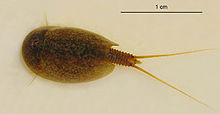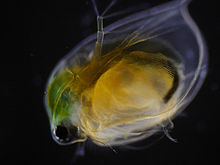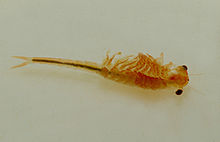Branchiopoda
The leaf-footed crustaceans (Phyllopoda) or gill-footed crustaceans (Branchiopoda) represent a summary of the gill-footed crustaceans (Anostraca), the back-shelled crustaceans (Notostraca; cf. among others Triops) as well as the claw-tails (Onychura).
The leaf-footed crustaceans are typical freshwater inhabitants that originally evolved from marine ancestors. Secondarily, some species have returned to the sea. Recent forms have survived mainly in relict and extreme biotopes (e.g. temporary waters, inland salt lakes).
Arguments for a monophyly of the leaf-footed crustaceans are their amoeboid-like spermatozoa, the filtering apparatus formed by bristly trunk extremities, and the construction of their nauplius larvae.
The trunk extremities of the leaf-footed crustaceans (Branchiopoda) were originally two-branched leaf legs and thus gave them their name. They originally have three functions. Breathing is done by the gills (epipodites) located at the outer base of the legs. Food intake is initially done with the help of the filter apparatus, which is formed by the long-branched leaf legs on the trunk. Adjacent leaf legs successively form temporary suction chambers. The resulting water flow drives food particles from the medium into the bristle combs of the leaf legs. Subsequently, further bristles located at the inner leg base guide the filtered out food particles in a ventral food channel to the mouth. Locomotion is by metachronous leg flapping and is combined with the described filter feeding. The legs may be secondarily modified, especially in miniaturized forms.
The Nauplius larva of the leaf-footed crustaceans (Branchiopoda) has undivided I. antennae. On the bristles of the II. antennae there is an articulated zone. The mandibles are single-branched. The labrum is elongated.
The system of the leaf-footed crustaceans (Branchiopoda) is shown with its subgroups in the following.
Arguments for a monophylum Phyllopoda consisting of dorsal shells (Notostraca) and clawed tails (Onychura) are the inclusion of the compound eyes in a pocket of the head capsule (internalization) and the 4-cuped nauplius eye, if the latter represents a derived state.
Arguments for a monophyly of the clawed tails (Onychura) are the secondary body-enveloping carapace, the reduction of the primary carapace to a head shield, and the clawed nature of the tail fork (furca).
Apomorphies are lacking to establish a monophyly "Conchostraca" within the claw-tailed Onychura consisting of Laevicaudata and Spinicaudata. Previously recognized characters have been found to converge.
Furthermore, the species Cyclestheria hislopii does not belong to the Spinicaudata, but forms a monophylum with the Cladocera. This is supported by the apomorphy of the annual cycle of parthenogenetic and bisexual generations, which occurs in both taxa.
An alternative relationship hypothesis comes from Ax (1999). According to this hypothesis, the higher crustaceans (Malacostraca) are within the leaf-footed crustaceans (Branchiopoda) and form with them the monophylum of the Phyllopodomorpha. This alternative hypothesis results in the following system:

Scaly-tailed or Spring-breasted Scaler, Lepidurus apus (Notostraca)

Water flea (Daphnia spp.) in dark field

Juvenile of a fairy crab, also called spring gill-foot crab, Eubranchipus grubii (Anostraca)
Search within the encyclopedia